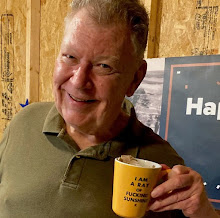 |
Fred, Freddie, and Booker Noe, at the Jim
Beam Distillery, Bullitt County, Kentucky. |
What's in a name? That which we call a rose
By any other name would smell as sweet;
So Romeo would, were he not Romeo call'd,
Retain that dear perfection which he owes
Without that title. Romeo, doff thy name,
And for that name which is no part of thee
Take all myself.
That’s my message to members of the Beam family who were saddened by the May first corporate name change, from Beam Suntory to Suntory Global Spirits. As Juliet says, that name is no part of thee. The Beam name and all it represents can never be erased.
When Jacob Beam came to Kentucky from Maryland at the end of the 18th century, he had already undergone a name change himself, from Johannes Jacobus Boehm to Jacob Beam.
He had at least one son, David, who joined and followed him in the whiskey business. The third generation produced three successful whiskey makers. By the fourth generation, Beam family members were everywhere in bourbon country.
That takes us to the end of the 19th century, when brothers Jim and Park Beam, along with their brother-in-law, Albert Hart, took over the operation begun by their great-grandfather. The distillery was called Beam & Hart. Their uncles and cousins were making whiskey too, at other companies.
The Beam & Hart Distillery was on Nazareth Road (now Old Nazareth Road), about three miles north of Bardstown, near the Sisters of Charity of Nazareth religious community. Beam & Hart’s main bourbon was called Old Tub. They operated at Nazareth until Prohibition (1920).
During Prohibition, the brothers bought the property where the Jim Beam Clermont distillery is now, about 20 miles northwest of the Nazareth place in Bullitt County. It had been a distillery, but the property also included a gravel quarry, a going business at the time.
After Prohibition, with their sons, the Beam brothers rebuilt and reopened the distillery at Clermont. There were some problems with ownership of the Old Tub brand name, so Jim Beam became the name of the brand and company.
In the 1940s, the family sold the company to a trio of Chicago investors. The new owners kept the name, and the family. Jim’s son, Jere (pronounced “Jerry,” short for Jerimiah), continued to run the business side while Park’s sons, Earl and “Shucks,” made the whiskey. Now called Jim Beam Brands, the company was based in Chicago.
Jim Beam Bourbon’s popularity soared in the 1960s. Harry Blum, by then sole owner, sold the company to American Tobacco. Today, Blum’s grandson runs a cannabis company.
At the distillery in Kentucky, on the whiskey-making side of the business, Park Beam’s grandsons, Baker and David, were joined by their cousin, Booker Noe, son of Jim Beam’s daughter, Margaret. The company bought a second distillery, in Nelson County, and had Booker run it. It now bears his name. There were other family members here and there in the company.
Meanwhile, the new owner, American Tobacco, morphed into a diversified conglomerate called Fortune, which used its Jim Beam Brands subsidiary to acquire additional assets in the beverage alcohol space. They successfully converted Jim Beam Brands from a bourbon company into a diversified beverage alcohol company with a broad portfolio. In 2006, following a major acquisition that brought Maker’s Mark into the fold, Fortune changed the subsidiary’s name to Beam Global Spirits and Wine.
By that time, diversified conglomerates like Fortune Brands were out of favor with investors. Fortune began to sell off pieces of itself. In December 2010, it was split into three chunks, representing its three remaining businesses: distilled spirits, home and security, and golf products.
Earlier in 2010, Pershing Square Capital Management, Bill Ackman’s hedge fund, became Fortune’s majority shareholder. Ackman pushed hard and publicly for a break-up. In 2011, Fortune became a "pure play" beverage alcohol company and changed its corporate name to Beam, Inc.
Company management hoped that would be good enough, but Ackman wasn’t finished. He kept pushing for more divestment. Almost exactly 10 years ago, Ackman got his way. Beam Inc. was sold to Suntory Holdings Limited, a privately held company based in Japan. Its distilled spirits division became Beam Suntory. In 2022, Beam Suntory moved its headquarters to Suntory’s offices in New York. Earlier this month, “Beam” was deleted from the name. That division is now called Suntory Global Spirits.
Meanwhile, and apropos Juliet’s admonition, nothing has changed in Kentucky, where all the company’s bourbon and rye whiskeys are made. Beam descendants still have a large say in how those whiskeys are made. The revived American whiskey business is full of Beams, whether they have the surname or not. For all of them, it is better to not share their name with a huge, international company they do not control and have not controlled for 80 years. Beam for the Beams.
Romeo, after all, has the final word on the subject: “Call me but love, and I'll be new baptized.”




























